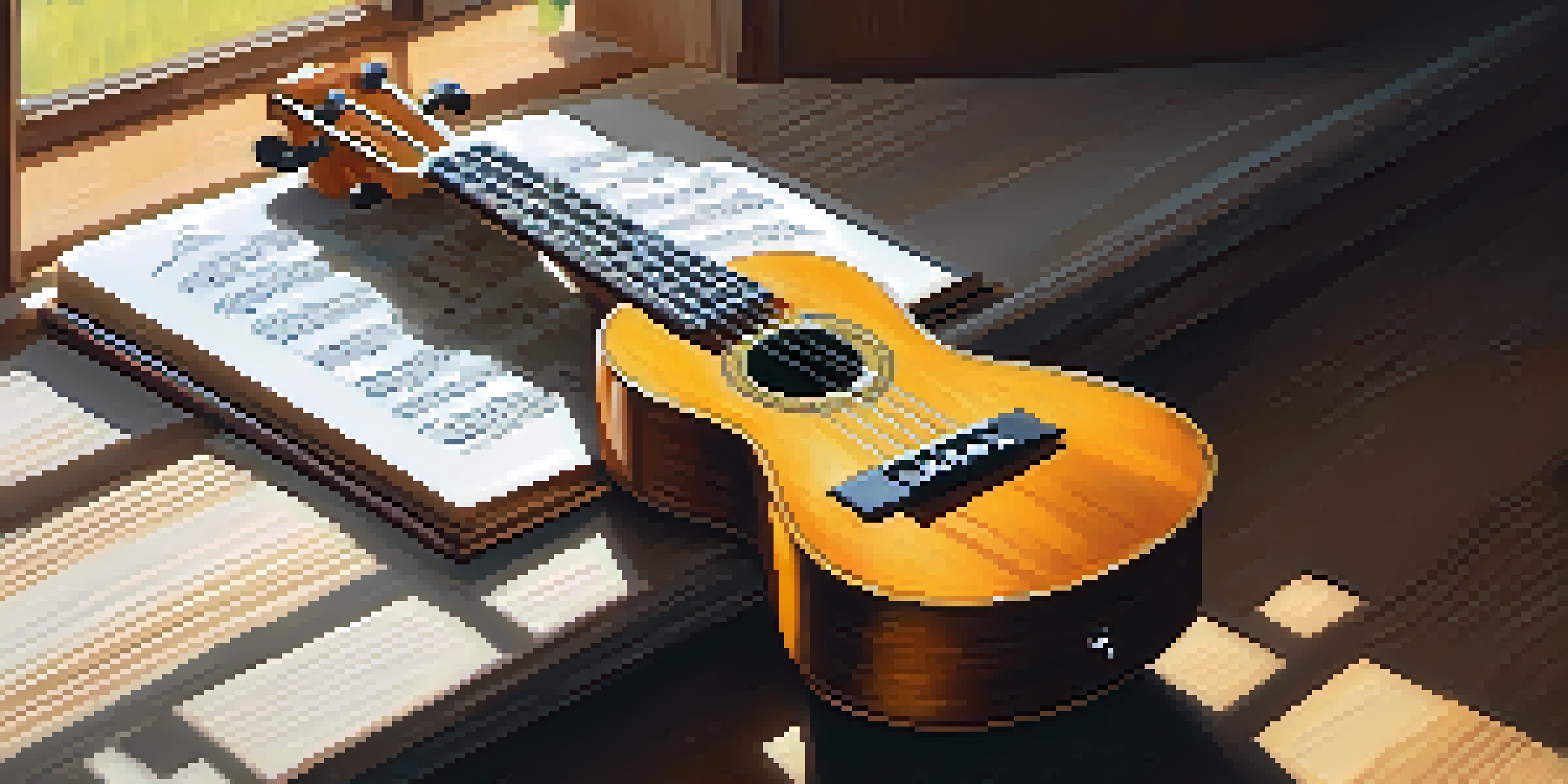The Art of Transposing: Changing Keys in Ukulele Songs

Understanding Transposition and Its Importance
Transposition is the process of changing the key of a song while maintaining its melody and harmony. For ukulele players, this skill can unlock a whole new world of musical possibilities. By shifting the key, you can adapt songs to better suit your vocal range or the sound you're aiming for.
Transposition is the process of changing the key of a song while maintaining its melody and harmony.
Imagine you’re singing a song that feels just a bit too high; transposing it down can make it a breeze to sing along. This not only enhances your enjoyment but also ensures that the music fits your unique style. Plus, it’s a great way to impress friends at your next jam session!
In essence, mastering transposition allows you to take control of your music. Whether you’re a beginner or a seasoned player, understanding this concept can significantly broaden your repertoire and make your ukulele experience even more rewarding.
The Basics of Music Keys and Scales
Before diving into transposing, it's essential to grasp the basics of music keys and scales. Each key has a specific set of notes that create its unique sound, and scales are simply sequences of these notes. For ukulele players, familiarizing yourself with major and minor scales can make transposing much more intuitive.

Think of keys as different colors on an artist’s palette; each one contributes to the overall mood of your music. By understanding the relationship between these keys, you’ll find it easier to shift a song into a different one without losing its essence. It’s like painting with different shades while keeping the same theme.
Transposition Enhances Musical Flexibility
Transposing allows musicians to adapt songs to their vocal range and style, unlocking new musical possibilities.
Ultimately, knowing your scales not only helps with transposing but also improves your overall musicianship. When you understand how notes interact within a key, you can make more informed decisions about which key to choose for a song.
How to Identify the Original Key of a Song
Identifying the original key of a song is the first step in the transposing process. Most songs will have a distinct starting chord or a chord progression that can indicate the key. For example, if a song starts with a C major chord, it’s likely in the key of C.
Music is the shorthand of emotion.
Listening closely to the song can also give you clues. Pay attention to which chords feel like they resolve or create tension; these often point to the key center. It’s a bit like being a detective, piecing together clues to uncover the song’s fundamental structure.
Once you’ve determined the original key, you’re ready to start transposing. This foundational step makes the rest of the process smoother and ensures that your adjustments will maintain the song’s integrity.
Using a Capo for Easy Transposition
A capo is a handy tool for ukulele players that can simplify the transposition process. By placing a capo on the fretboard, you can easily raise the pitch of the strings, effectively changing the key without having to learn new chord shapes. This is especially useful for beginners still getting comfortable with chord fingerings.
For instance, if you have a song in the key of C but want to play it in D, simply place the capo on the second fret. This allows you to use the same chord shapes while sounding in a different key. It’s a straightforward solution that can save you time and frustration.
Understanding Keys Simplifies Transposing
Familiarity with music keys and scales makes the transposition process more intuitive and effective.
Using a capo can also inspire creativity. Experimenting with different fret placements might lead you to discover new sounds and variations that you wouldn’t have explored otherwise.
Manual Transposition: Step-by-Step Guide
Transposing a song manually involves shifting each chord up or down by a certain number of steps. To start, identify how many half steps you want to transpose. If you are moving from C to D, you’re shifting up two half steps, which means every chord in the song will also need to move up by two.
Create a chart or reference guide to help you visualize this shift. For instance, C becomes D, G becomes A, and so on. This method is like creating your own map to navigate the musical landscape, ensuring you don’t get lost along the way.
Once you’ve mapped out the changes, play through the song in its new key. This hands-on approach solidifies your understanding of transposition and allows you to hear the differences immediately.
Practical Tips for Successful Transposing
When transposing, practice makes perfect. Start with simple songs that you’re already familiar with, as this will help you focus on the key changes rather than the song structure. Gradually, as you become more comfortable, you can tackle more complex pieces.
Another tip is to sing along while you transpose. This helps you stay in tune with the new key and ensures that the adjustments feel natural. It’s like having a built-in feedback system; if something sounds off, you can quickly make corrections.
Capos Simplify Key Changes
Using a capo enables ukulele players to easily change keys without learning new chord shapes.
Lastly, don’t hesitate to use online tools or apps designed to assist with transposing. These can be great resources to double-check your work and provide you with instant feedback, making the learning process smoother and more enjoyable.
Exploring the Benefits of Transposing in Your Playing
Transposing not only enhances your playing skills but also deepens your understanding of music theory. By regularly practicing this technique, you become more versatile and adaptable as a musician. You’ll find that songs can take on a new life in different keys, revealing hidden nuances.
Additionally, transposing can boost your confidence as a performer. Being able to adjust a song on the fly to accommodate your voice or your audience’s preferences shows a level of musicality that is sure to impress. It’s like being a musical chameleon, effortlessly blending into any situation.

Ultimately, the art of transposing opens the door to greater creativity and expression in your playing. The more you explore this skill, the more you’ll discover your unique musical voice.